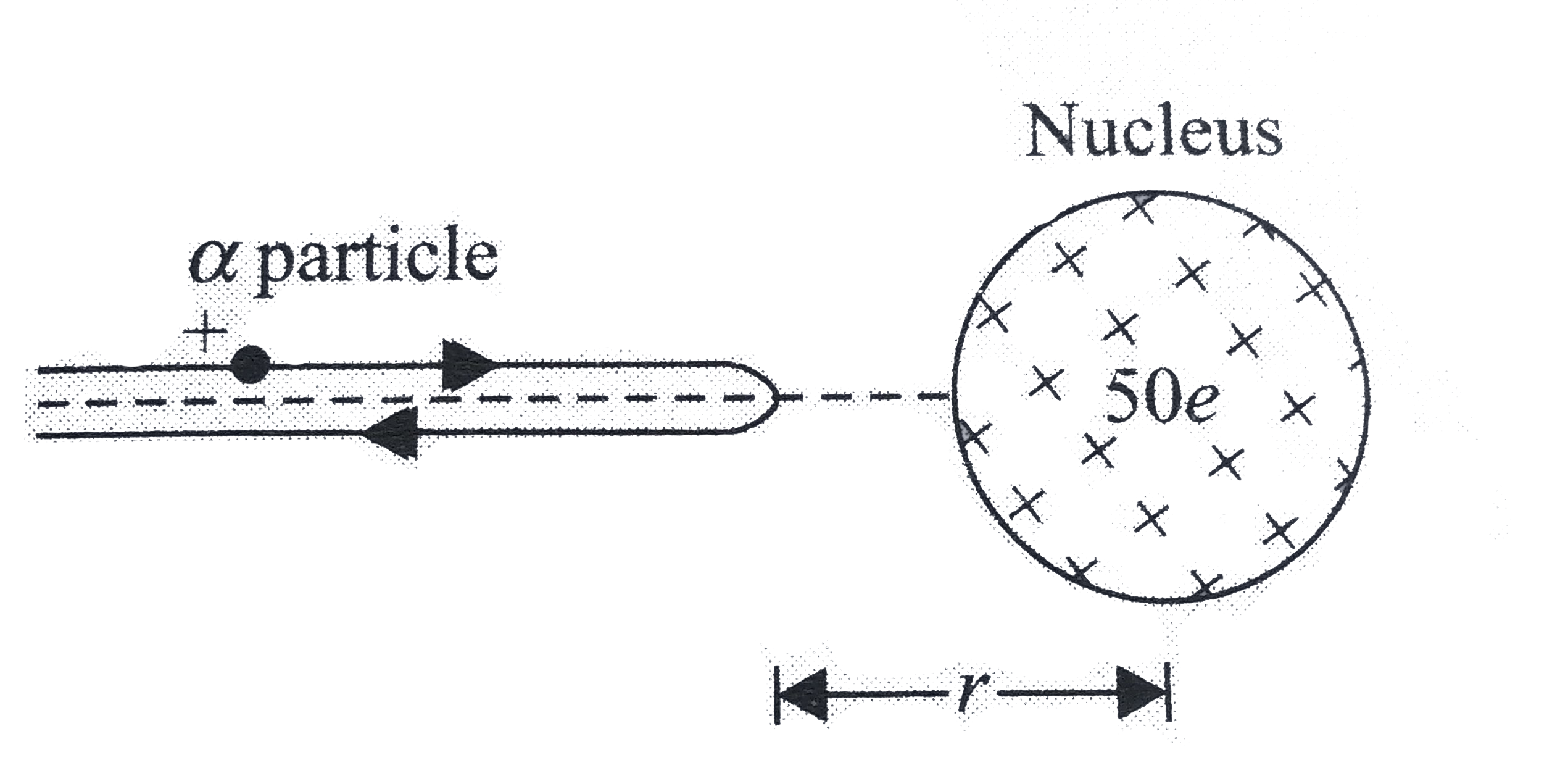An alpha particle of energy 5MeV is scattered through 180∘ by a found uramiam nucleus . The distance of closest approach is of the order of
1 Å
10−10 cm
10−12 cm
10−15 cm
The correct Answer is:C
To find the distance of closest approach of an alpha particle (with energy 5 MeV) when it is scattered by a uranium nucleus, we can use the principle of conservation of energy. Here's the step-by-step solution:
Step 1: Identify the Charges
An alpha particle consists of 2 protons and 2 neutrons, giving it a charge of +2e. The uranium nucleus (U-235) has 92 protons, giving it a charge of +92e.
Step 2: Write the Conservation of Energy Equation
Initially, the alpha particle has kinetic energy and no potential energy when it is far away. At the point of closest approach, all the kinetic energy is converted into potential energy. Thus, we can write:
Initial Kinetic Energy+Initial Potential Energy=Final Kinetic Energy+Final Potential Energy
This simplifies to:
KEi+0=0+PEf
Where:
- KEi=5MeV=5×106eV
- PEf=k⋅q1⋅q2D
Step 3: Substitute Values
Here, k (Coulomb's constant) is approximately 9×109N m2/C2, q1=2e, and q2=92e. The potential energy at the distance of closest approach can be expressed as:
PEf=k⋅(2e)⋅(92e)D
Step 4: Convert Electron Charge to SI Units
The charge of an electron e is approximately 1.6×10−19C. Thus:
PEf=9×109⋅(2⋅1.6×10−19)⋅(92⋅1.6×10−19)D
Step 5: Set Up the Equation
Now we equate the initial kinetic energy to the potential energy at the closest approach:
5×106eV=9×109⋅(2⋅1.6×10−19)⋅(92⋅1.6×10−19)D
Step 6: Solve for D
Rearranging gives:
D=9×109⋅(2⋅1.6×10−19)⋅(92⋅1.6×10−19)5×106
Calculating the numerator:
=9×109⋅(2⋅1.6×10−19)⋅(92⋅1.6×10−19)=9×109⋅2⋅92⋅(1.6×10−19)2
Calculating (1.6×10−19)2:
=2.56×10−38
Now substituting back:
D=9×109⋅2⋅92⋅2.56×10−385×106
Calculating the values gives:
D≈5.3×10−14m
Step 7: Convert to Centimeters
To convert meters to centimeters:
D≈5.3×10−14m=5.3×10−12cm
Conclusion
Thus, the distance of closest approach is of the order of 10−12cm.
An alpha particle consists of 2 protons and 2 neutrons, giving it a charge of +2e. The uranium nucleus (U-235) has 92 protons, giving it a charge of +92e.
Initially, the alpha particle has kinetic energy and no potential energy when it is far away. At the point of closest approach, all the kinetic energy is converted into potential energy. Thus, we can write:
- KEi=5MeV=5×106eV
- PEf=k⋅q1⋅q2D
Here, k (Coulomb's constant) is approximately 9×109N m2/C2, q1=2e, and q2=92e. The potential energy at the distance of closest approach can be expressed as:
The charge of an electron e is approximately 1.6×10−19C. Thus:
Now we equate the initial kinetic energy to the potential energy at the closest approach:
Rearranging gives:
To convert meters to centimeters:
Thus, the distance of closest approach is of the order of 10−12cm.
Topper's Solved these Questions
- ELECTROSTATICSBOOK - DC PANDEY ENGLISHCHAPTER - ELECTROSTATICSEXERCISE - JEE Advanced
44 Videos
- ELECTROSTATICSBOOK - DC PANDEY ENGLISHCHAPTER - ELECTROSTATICSEXERCISE - Comprehension
36 Videos
- ELASTICITYBOOK - DC PANDEY ENGLISHCHAPTER - ELASTICITYEXERCISE - Medical entrances s gallery
21 Videos
- EXPERIMENTSBOOK - DC PANDEY ENGLISHCHAPTER - EXPERIMENTSEXERCISE - Subjective
15 Videos
Similar Questions
An α-particle having K.E.=7.7MeV is scattered by gold (z=79) nucleus through 180∘ Find distance of closet approach.
View SolutionAn α-particle accelerated through V volt is fired towards a nucleus . Its distance of closest approach is r. If a proton acceleration throught the same potential is fired towards the same nucleus, the distance of closest approach of proton will be xr. Find value of x.
View Solution(a) Define the distance of closest approach. A α -particle of kinetic energy K is bombarded on a thin gld foil. The distance of the closest approach is ra. What will be the distance of closest approach for an α-particle of double the kinetic energy ?
(b) Show that the radius of the orbit of an electron in hydrogen atoms varies as n2, where n is the principal quantum number of the atom.
View SolutionDefine the distance of closest approach. An α-particle of kinetic enegy 'K' is bombarded on a thin gold foil. The distance of the closest approach is 'r' . What will be the distance of closest approach for an α-particle of double the kinetic energy ?
View SolutionWhen an α−particle of mass 'm' moving with velocity 'v' bombards on a heavy nucleus of charge 'Ze' its distance of closest approach from the nucleus depends on m as :
View SolutionWhen an α−particle of mass 'm' moving with velocity 'v' bombards on a heavy nucleus of charge 'Ze' its distance of closest approach from the nucleus depends on m as :
View SolutionWhen an α particle of mass m moving with velocity v bombards on a heavy nucleus of charge Ze, its distance of closest approach form the nucleus depends on m as
View SolutionAn alpha nucleus of energy 12mν2 bombards a heavy nucleus of charge Ze . Then the distance of closed approach for the alpha nucleus will be proportional to
View SolutionAn alpha nucleus of energy 12mν2 bombards a heavy nucleus of charge Ze . Then the distance of closed approach for the alpha nucleus will be proportional to
View SolutionAn alpha particle with kinetic energy 10MeV is heading toward a stationary tin nucleus of atomic number 50. Calculate the distance of closest approach (Fig . 3.23).
 .
.
View Solution
